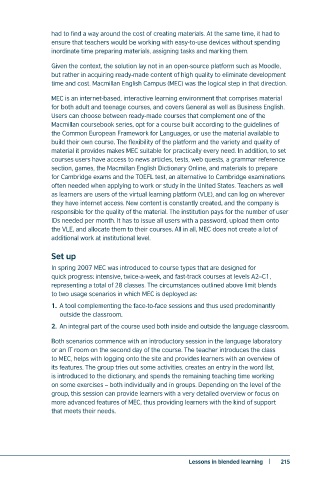Page 218 - BLENDED LEARNING
P. 218
had to find a way around the cost of creating materials. At the same time, it had to
ensure that teachers would be working with easy-to-use devices without spending
inordinate time preparing materials, assigning tasks and marking them.
Given the context, the solution lay not in an open-source platform such as Moodle,
but rather in acquiring ready-made content of high quality to eliminate development
time and cost. Macmillan English Campus (MEC) was the logical step in that direction.
MEC is an internet-based, interactive learning environment that comprises material
for both adult and teenage courses, and covers General as well as Business English.
Users can choose between ready-made courses that complement one of the
Macmillan coursebook series, opt for a course built according to the guidelines of
the Common European Framework for Languages, or use the material available to
build their own course. The flexibility of the platform and the variety and quality of
material it provides makes MEC suitable for practically every need. In addition, to set
courses users have access to news articles, tests, web quests, a grammar reference
section, games, the Macmillan English Dictionary Online, and materials to prepare
for Cambridge exams and the TOEFL test, an alternative to Cambridge examinations
often needed when applying to work or study in the United States. Teachers as well
as learners are users of the virtual learning platform (VLE), and can log on wherever
they have internet access. New content is constantly created, and the company is
responsible for the quality of the material. The institution pays for the number of user
IDs needed per month. It has to issue all users with a password, upload them onto
the VLE, and allocate them to their courses. All in all, MEC does not create a lot of
additional work at institutional level.
Set up
In spring 2007 MEC was introduced to course types that are designed for
quick progress: intensive, twice-a-week, and fast-track courses at levels A2–C1,
representing a total of 28 classes. The circumstances outlined above limit blends
to two usage scenarios in which MEC is deployed as:
1. A tool complementing the face-to-face sessions and thus used predominantly
outside the classroom.
2. An integral part of the course used both inside and outside the language classroom.
Both scenarios commence with an introductory session in the language laboratory
or an IT room on the second day of the course. The teacher introduces the class
to MEC, helps with logging onto the site and provides learners with an overview of
its features. The group tries out some activities, creates an entry in the word list,
is introduced to the dictionary, and spends the remaining teaching time working
on some exercises – both individually and in groups. Depending on the level of the
group, this session can provide learners with a very detailed overview or focus on
more advanced features of MEC, thus providing learners with the kind of support
that meets their needs.
214 | Lessons in blended learning Lessons in blended learning | 215

